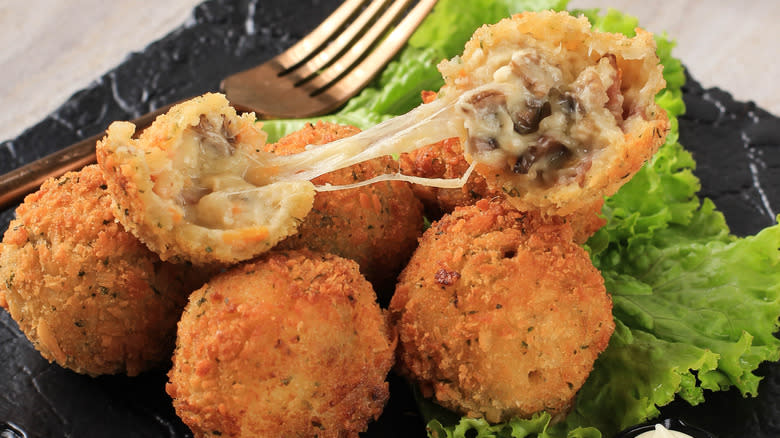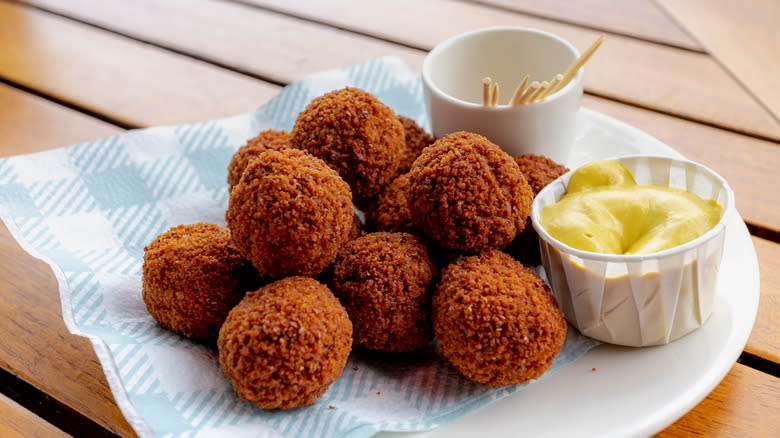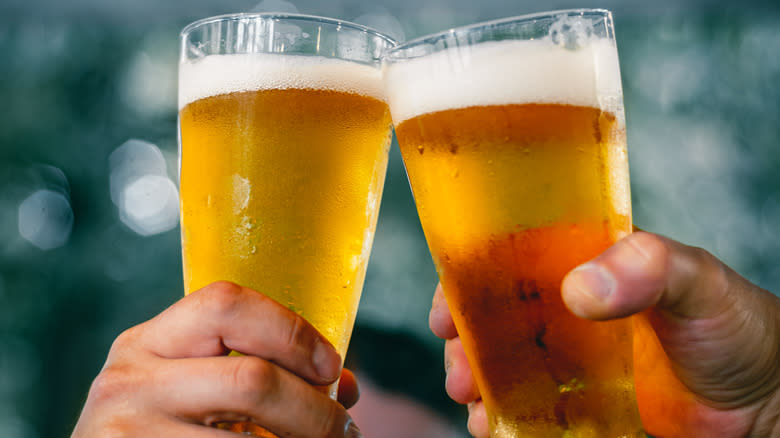The Dutch Snack You Can Find In Both Aruba And Amsterdam

Dutch food isn't as well-known globally as it should be. The Netherlands are great at producing types of pancakes, from the miniature butter and brown sugar-laden Amsterdam treat known as poffertjes, to pannenkoeken, the large, fluffy pancakes also called Dutch babies. Stamppot, meanwhile, is a must-have for any lovers of mashed potatoes from around the world. And if you're looking for a savory Dutch snack found not just in the Netherlands itself but in multiple former Dutch colonies like Aruba and Curaçao, bitterballen might be exactly what you're after.
Though there's a lot of variation among bitterballen, they boil down to the same core concept: meat stew (usually but not always beef) that's been allowed to congeal in the fridge, which is then rolled into a ball, coated with coarse bread crumbs, and fried. They get their name from the bitter liqueur they were typically served alongside, but with a core concept like deep-fried stew, it's frankly amazing that they're not already popular in countries like America that go nuts for fried food.
Read more: 15 Tips For Making The Best Meatloaf
Bitterballen Have A Long History And Have Traveled A Long Way

Though the progenitors of bitterballen could date to as early as 200 B.C., it's generally believed that the modern version was first created in the 17th century by the wife of an Amsterdam pub owner. For much of the 20th century, meanwhile, they were often utilized as a great way to use up leftovers and save money.
If you're wondering why you can find bitterballen in both Aruba and Amsterdam, the answer is simple: colonialism. Aruba was a Dutch colony (it became an autonomous kingdom in 1986), meaning you'll find plenty of Dutch as well as indigenous cultural influences on the island. Bitterballen is one of the best examples of this. Bitterballen are usually made with beef, but you might also see them with veal.
Regardless, the concept remains a meat ragout, possibly with vegetables such as carrots and onions and seasonings like nutmeg and maybe curry powder. Like a lot of good fried bar foods, it's also served with a dipping sauce (in this case mustard). You can think of them as the Dutch version of tapas -- which makes sense considering that Holland was under Spanish occupation when they were invented.
Bitterballen Are Often Part Of A Bittergarnituur

One of the most important aspects of bitterballen, though, aren't what they are, but what they're served with. You're most likely to see bitterballen served as a bar snack alongside drinks -- which is where the name comes from, because the dish itself certainly isn't bitter. Instead, the "bitter" in the name traditionally referred to jenever, a gin-like herb-and-juniper-flavored liqueur that they were served alongside. It's now far more common to eat them with beer, but the name remains.
Best of all, they're often not served alone, but as part of a Dutch appetizer platter known as a "bittergarnituur," which means "garnish for bitters." A bittergarnituur might come with kaasstengels (deep-fried cheese sticks), kipnugget (chicken nuggets), ossenworst (raw beef sausage), vlammetjes (miniature spring rolls), nasi-balletje (fried rice balls inspired by an Indonesian dish known as nasi goreng), frikandel (long, skinless deep fried sausage), and pieces of Gouda cheese. Though the ingredients in a bittergarnituur do vary, it almost always contains bitterballen -- no surprise, given the name.
Read the original article on Daily Meal


